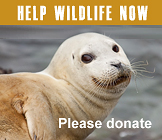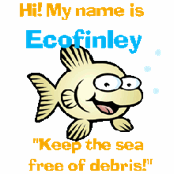Tiny
Seal pup Sandy drowns in fishing gear
Apr/01/12 07:52 PM
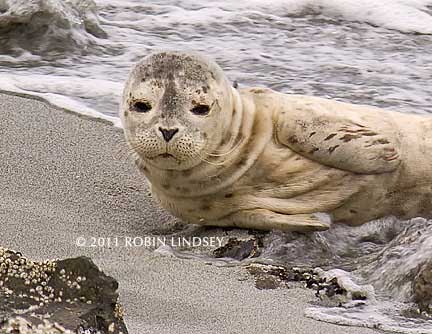
Sandy was only three weeks old, weighing 7.1 kgs (a third of normal body weight for a nursing pup), when she was rescued by Seal Sitters from a West Seattle beach on August 15, 2011 (photo right). She spent a lengthy 5 month rehab at PAWS, but was a robust pup when finally released at a harbor seal rookery in South Puget Sound. Through the combined efforts of PAWS, NOAA, SeaDoc Society and WDFW Marine Mammal Investigations, Sandy was fitted with the satellite tag in order to provide valuable data to researchers. The satellite revealed she stayed relatively close to the release point for the first few days, but then she began taking off on adventures - south to Olympia, north to the San Juans, circling Vashon, back to Olympia and Shelton, up to Edmonds a couple of times. After being in a small pool for so many months, it seemed as though she had the travel bug and appeared to be thriving in the wild (map below shows her travels). The last satellite hit was on the 27th.
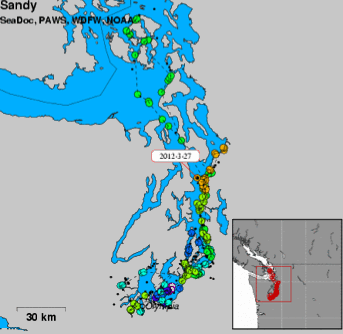
Sandy is not the only harbor seal with a West Seattle connection to die from fishing gear. A few days before we rescued her last August, we responded to a dead adult female on Beach Drive. The necropsy showed that the female had given birth within ten days or so and the cause of death was from fishing line and lure, twisting the female’s stomach and causing an agonizing death. A newborn pup we nicknamed Tiny died on another beach the same day as the necropsy. It is not beyond the realm of speculation that Tiny was this female’s pup and that fishing gear caused the death of both animals.
This is truly a very sad day. Special thanks to PAWS’ staff who nursed Sandy back to health and cared for her for so many months. For those of us who participated in her release, we will never forget the joy of seeing her swimming free in the Sound with that little yellow-green satellite hat. SS volunteers and Puget Sound residents signed up to receive SeaDoc Society email alerts and excitedly followed her movements online. To read more about Sandy and view the video of her release back to the wild, click here.
To learn more about the dangers of marine debris and how you can help, click here.
NOTE TO DIVERS:
If you are a diver and come upon animals who have died in derelict gear, we ask two things. First, please take a photograph and email a jpg to us. We will forward the photos to the appropriate person for a corresponding database - this will greatly help assess the true number of animals that perish each year. Secondly, please indicate the location of the derelict gear if you have lat/long finder and we will report it to the Northwest Straits Derelict Fishing Gear Removal Program which estimates that 50,000 animals are entangled and die each year in Washington waters just in shallow water nets and gear (excluding an unknown number in deep-water derelict gear). Harbor seals had by far the highest number of deaths among marine mammals in gear they removed. According to their website :
As of November 30, 2011, the Northwest Straits Initiative has removed 4,081 derelict fishing nets and 2,668 crab pots from Puget Sound, restoring 596 acres of critical marine habitat. Over 241,700 animals, representing more than 240 species, were found entangled in this gear.
Please spread this message among your diving community and make a difference for the marine mammals of Washington. Do not attempt to remove fishing gear - it is extremely dangerous. NW Straits has informed us that a diver drowned in Puget Sound a few years ago on a sport fishing line cleanup.
Frosty's death a harsh reality for weaned pups
Dec/30/11 07:47 AM
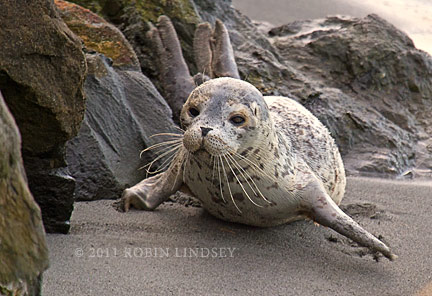
Around 9pm Saturday night, the hotline received a call of a pup “sleeping peacefully” on the beach. Our responder instead found a dead pup. There, in the darkness, we examined both the pup and the area surrounding him. There were no human footprints or animal tracks to indicate foul play or the presence of a predator nor any obvious cause of death. By the beam of the flashlight, our investigator was saddened by the realization that it was most likely Frosty, who had distinctive markings under his eyes (photo comparisons late that night confirmed the identity). We could see his haulout tracks leading a distance up from the water’s edge to the rocks below the sea wall and his return tracks halfway back to the Sound where he died.
Frosty’s body was delivered to the WDFW Marine Mammal Investigations Unit early Christmas morning for necropsy. Many thanks to volunteer Theresa for making that long, sad drive on a holiday. The subsequent necropsy revealed that Frosty had been foraging very successfully, with a belly of fish bones and parts, and was in fair body condition. However, his lungs and trachea were filled with lungworms and he had pneumonia complicated by a bacterial infection. The biologist was amazed that he had been able to continue to dive and catch fish with such limited lung capacity.
So, why is it that weaned pups are so much more at risk for parasite loads and infection than adult seals? As Dyanna Lambourn, WDFW marine mammal biologist explains, a nursing pup gains temporary or “passive” immunity from mom’s milk which contains a high density of white blood cells. While nursing, if that pup is exposed to a parasite or virus, his body will begin to develop its own antibodies - all the while being stimulated and reinforced by mom’s immunity. Once weaned, however, the pup’s immune system no longer has that support and quickly becomes suppressed. If the now vulnerable pup is exposed to a new worm or virus, he may not be able to build antibodies quickly enough to fight it off or the accompanying complications. As Dyanna says, it is similar to sending your child off to kindergarten, where suddenly she is exposed to a myriad of new “bugs.” But pups weaned at only 4-6 weeks don’t have mom’s milk and protection to nurse them back to health.
Weaned pups face extreme challenges. Learning to catch fish can be a daunting task. As they struggle to learn to forage on their own and become thinner, losing that layer of blubber that provides warmth and energy, opportunistic parasites and viruses can take hold. Contaminants in our polluted waters drastically compound the risk to weaned pups. Storm runoff contaminants, such as pcbs and flame retardants, enter the food chain and further weaken a pup’s already compromised immune system.
As we have stated many times in our public outreach, a seal pup has only a 50% chance of survival the first year. This is why it is so imperative that people allow them the best chance possible - by giving them space on shore to rest and warm up. This simple act can truly be the difference between life and death. The total number of dead pups in West Seattle since August has now reached 16 - while only 5 of those belonged to our database of the 50 pups we’ve watched over this season (Tiny, Bianca, Qayak, Aquarius and now, Frosty). This white little pup Frosty brought a tremendous amount of joy and awareness to all who watched over him this Christmas season.
Sad news from Arroyo Beach
Aug/12/11 08:14 AM
(see update end of story) Seal Sitters is so sad to report that our first pup of the year, Tiny, died on Arroyo Beach yesterday afternoon. Tiny had rested there all day Wednesday, returning to the water briefly, only to haul out again on a timber in the water until after dark. Early in the morning, Tiny was reported gone. Our responder hiked and scoured a huge expanse of beach almost to Brace Point, as well as beaches to the south. However, Tiny was sleeping tucked in among some rocks at the sea wall, unseen. Later that afternoon, he was discovered by a homeowner who called the hotline. Tiny died trying to return to the Sound as our volunteers arrived on scene.
Yesterday morning Seal Sitters assisted in the necropsy by WDFW Marine Mammal Investigations of an adult female seal just north of Lowman Beach. The female was postpartum and WDFW’s biologist estimated that the seal had given birth approximately 10 or so days before. This would very closely match the estimated age of Tiny when he showed up at the north end of Lincoln Park, just a short distance away. While we cannot say with certainty that the female was indeed his mom, it seems quite likely. Our investigator was troubled that the pup was not gaining weight if indeed he was being nursed; however, his pattern of returning to the water, traveling a fair distance to Arroyo Beach south of the park, and the fact that an adult seal had been seen on the platform offshore all contributed to the possibility that he had a mom around. With limited resources for rehabilitation in our area (in addition to the low success rates of rehabbing a newborn pup) it is always best for a pup to remain in the wild with mom if at all possible. Such a small pup needs mom to teach foraging skills to survive in the wild; while rehabbers do an amazing job, those innate survival skills cannot be taught by humans tossing fish in a small pool. A pup always has his best chance of survival with mom’s tutelage on how to forage successfully for food, all the while nursing on her rich milk.
A necropsy will be performed on the pup and we will provide updates to cause of death for both seals as results become available. This is, by far, the hardest part of the work we do. This little seal brought great joy to our volunteers and neighbors who watched over him. Tiny’s short life enlightened many to the struggles that seal pups face and the urgent need to let them rest. We are terribly sad, but heartened to know that we will have many success stories over the next months.
NECROPSY RESULTS 8/15/11: Tiny, a male pup, weighed 10 kg (approx 22 lbs) and had a very thin blubber layer.
Yesterday morning Seal Sitters assisted in the necropsy by WDFW Marine Mammal Investigations of an adult female seal just north of Lowman Beach. The female was postpartum and WDFW’s biologist estimated that the seal had given birth approximately 10 or so days before. This would very closely match the estimated age of Tiny when he showed up at the north end of Lincoln Park, just a short distance away. While we cannot say with certainty that the female was indeed his mom, it seems quite likely. Our investigator was troubled that the pup was not gaining weight if indeed he was being nursed; however, his pattern of returning to the water, traveling a fair distance to Arroyo Beach south of the park, and the fact that an adult seal had been seen on the platform offshore all contributed to the possibility that he had a mom around. With limited resources for rehabilitation in our area (in addition to the low success rates of rehabbing a newborn pup) it is always best for a pup to remain in the wild with mom if at all possible. Such a small pup needs mom to teach foraging skills to survive in the wild; while rehabbers do an amazing job, those innate survival skills cannot be taught by humans tossing fish in a small pool. A pup always has his best chance of survival with mom’s tutelage on how to forage successfully for food, all the while nursing on her rich milk.
A necropsy will be performed on the pup and we will provide updates to cause of death for both seals as results become available. This is, by far, the hardest part of the work we do. This little seal brought great joy to our volunteers and neighbors who watched over him. Tiny’s short life enlightened many to the struggles that seal pups face and the urgent need to let them rest. We are terribly sad, but heartened to know that we will have many success stories over the next months.
NECROPSY RESULTS 8/15/11: Tiny, a male pup, weighed 10 kg (approx 22 lbs) and had a very thin blubber layer.
Tiny finds new, quieter place to rest
Aug/10/11 03:27 PM
Concerned and respectful neighbors spread the word that there was a resting pup and for dog owners to please keep their dogs off the beach.
Tiny visitor comes ashore today - first pup of the season
Aug/09/11 06:43 PM
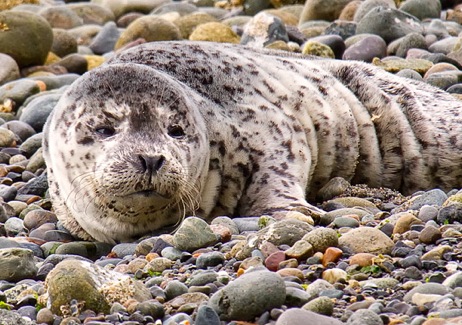
Please be on the lookout for Tiny. The pebbled coat provides excellent camouflage on the beach, so be alert as you walk along. If you see him, please make sure to keep people and dogs away and call our hotline @ 206-905-SEAL (7325). It is imperative that a nursing pup not be scared back into the water, venturing off to another location where mom can’t find him. The pup does not have the means to survive on his own.
UPDATE 8/10/11 5:38am
It has been verified that the pup has a small stub of umbilicus and is estimated at little more than a week old. Many thanks to WDFW’s Dyanna Lambourn for her on-going expertise and help advising Seal Sitters in matters of health concerns!

